| You are invited to view a photo from Paul's photo album: Lower Madawaska WW Canoe Message from Nigel: Boof! If you are having problems viewing this email, copy and paste the following into your browser: http://picasaweb.google.com/lh/photo/F0wl4HQi8ckQ0Km9GMM9-A To share your photos or receive notification when your friends share photos, get your own free Picasa Web Albums account. |
Friday, September 26, 2008
Invitation to view a photo from Paul's Picasa Web Album - Lower Madawaska WW Canoe
Invitation to view a photo from Paul's Picasa Web Album - Lower Madawaska WW Canoe
| You are invited to view a photo from Paul's photo album: Lower Madawaska WW Canoe Message from Nigel: Paul meets the Lower Mad! If you are having problems viewing this email, copy and paste the following into your browser: http://picasaweb.google.com/lh/photo/ogc0jhpPPhVsod-MrpBDhg To share your photos or receive notification when your friends share photos, get your own free Picasa Web Albums account. |
Invitation to view a photo from Paul's Picasa Web Album - Lower Madawaska WW Canoe
| You are invited to view a photo from Paul's photo album: Lower Madawaska WW Canoe Message from Nigel: Lower Mad! If you are having problems viewing this email, copy and paste the following into your browser: http://picasaweb.google.com/lh/photo/idELraswjTUC4FuZd7f2sg To share your photos or receive notification when your friends share photos, get your own free Picasa Web Albums account. |
Thursday, September 25, 2008
Busy, busy, busy.
Sent to you by nigel via Google Reader:
Things you can do from here:
- Subscribe to indexed using Google Reader
- Get started using Google Reader to easily keep up with all your favorite sites
Where Nathan Phillips Landed
Sent to you by nigel via Google Reader:
Things you can do from here:
- Subscribe to Toronto Before using Google Reader
- Get started using Google Reader to easily keep up with all your favorite sites
Wednesday, September 24, 2008
North Dakota the most outgoing state, according to study of "the geography o...
Sent to you by nigel via Google Reader:
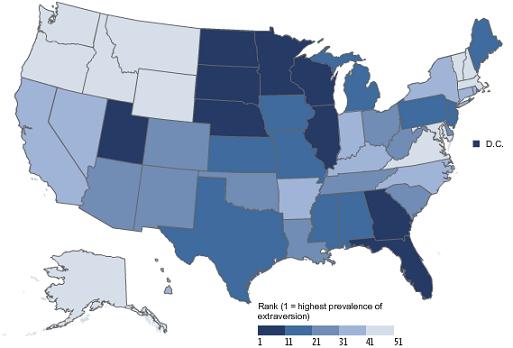
I'm coming a bit late to this one -- it's been heavily blogged in the last day or two -- but it's so lovely I can't pass it up. A team of scientists have produced a map of the "geography of personality" in the US: What sorts of people cluster in what states.
Specifically, it used a standard personality test that rates people based on the "big five" personality traits -- extraversion, agreeableness, conscientiousness, neuroticism and openness. The results? Highly conscientious states were a really mixed bag, including New Mexico, North Carolina, Utah and Florida. Super neurotic states included not only the obvious culprits -- New York and New Jersey -- but also Mississippi, Louisiana and Arkansas (the latter three possibly, the scientists surmise, because of the extremes of poverty found there).
As a story in the Wall Street Journal reports:
While the findings broadly uphold regional stereotypes, there are more than a few surprises. The flinty pragmatists of New England? They're not as dutiful as they may seem, ranking at the bottom of the "conscientious" scale. High scores for openness to new ideas strongly correlates to liberal social values and Democratic voting habits. But three of the top ten "open" states -- Nevada, Colorado and Virginia -- traditionally vote Republican in presidential politics. (All three are prime battlegrounds this election.)
And what of the unexpected finding that North Dakota is the most outgoing state in the union? Yes, North Dakota, the same state memorialized years ago in the movie "Fargo" as a frozen wasteland of taciturn souls. Turns out you can be a laconic extrovert, at least in the world of psychology. The trait is defined in part by strong social networks and tight community bonds, which are characteristic of small towns across the Great Plains. (Though not, apparently, small towns in New England, which ranks quite low on the extraversion scale.)
The Journal put together a very cool interactive map that shows the results for each major personality type. The academic study itself -- "A Theory of the Emergence, Persistence, and Expression of Geographic Variation in Psychological Characteristics" -- is online behind a paywall here.
Obviously, there are a zillion cavaets here, including the fact that a lot of psychologists think personality tests are a bunch of hooey (though the "big five" test has gained more respect in recent years). What's more, even if you grant the force of the test results, no one -- not even the authors -- can figure out whether the state "personality" emerges because of environmental factors or simply because people who are already pretty neurotic tend to move to New York.
Things you can do from here:
- Subscribe to collision detection using Google Reader
- Get started using Google Reader to easily keep up with all your favorite sites
Monday, September 22, 2008
We All Should Get U.S. Bailout Tombstones
Sent to you by nigel via Google Reader:
A friend of mine pointed out in an email this morning that since all we taxpayers are party to a big transaction (i.e., bailing out the U.S. financial system), Treasury should send us all fine new Lucite-encased tombstones for the deal. He sent a sample:
Thanks to Dan Gould for the excellent idea.
Things you can do from here:
- Subscribe to Paul Kedrosky's Infectious Greed using Google Reader
- Get started using Google Reader to easily keep up with all your favorite sites
Sunday Not-So-Funnies
Sent to you by nigel via Google Reader:
This one's from The Week:
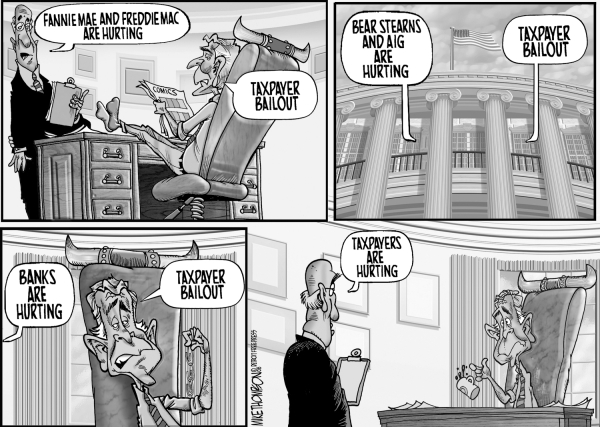
Here's one from the webcomic Sinfest that takes a cue from the film Titanic to remind us that the rich will go on:
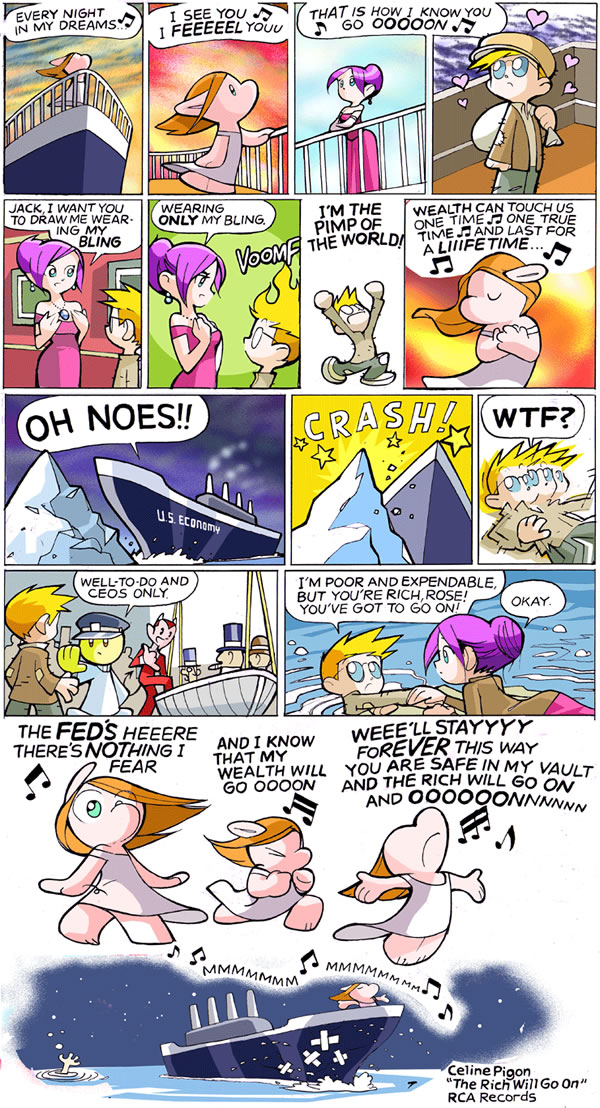
Here's one featuring a name that you should familiarize yourself with: Phil Gramm.
He was an official economic advisor to the McCain campaign — at least until he called America "a nation of whiners" in an attempt to downplay the idea that the country was in a recession. He's also one of the guys behind the Gramm-Leach-Bliley Act, which led to the deregulation of the banking industry that led to the current crisis.
He's still with the campaign on an unofficial basis and often travels with McCain. McCain also drops his name whenever questions of economics come up.

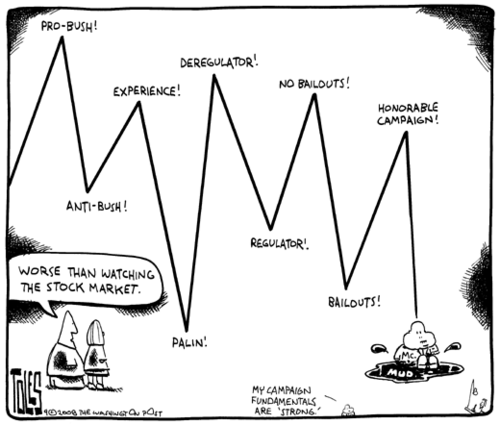
And finally, a poke at Reagan's joke "The nine most terrifying in the English language are: 'I'm from the government and I'm here to help.'"
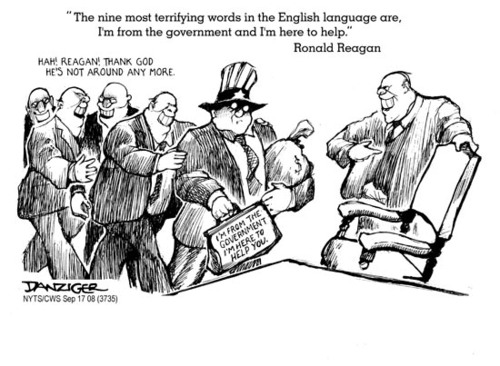
Things you can do from here:
- Subscribe to The Adventures of Accordion Guy in the 21st Century : Joey deVilla's Personal Blog using Google Reader
- Get started using Google Reader to easily keep up with all your favorite sites
Wednesday, September 17, 2008
A 10-foot spinning orb to replicate Earth's magnetic field
Sent to you by nigel via Google Reader:

Behold a 30-ton, 10-foot-high spinning ball of steel and sodium that is intended to simulate the Earth's magnetic field.
Why does this delightful and insane object exist? Because Dan Lathrop, a geophysicist at the University of Maryland, is trying to figure out whether the Earth's magnetic fields are going to "flip" soon and reverse polarity. The magnetic field is generated by the spinning motions of the Earth's 12,000-kilometer-thick liquid-iron core. Theoretically, a change in the direction or rate of spin is what flips the north/south polarity, though scientists really don't understand how this works. We know that the field has flipped hundreds of times in the past; the rock record shows this.
However, since the last flip was 780,000 years ago, we don't know how a flip would affect life on Earth. It could be pretty nasty: The magnetic field deflects a lot of the Sun's incredibly nasty radiation, so if you take it away, we could all get microwaved to a crisp. (You may recall that this was the plot to the lafftastically awful sci-fi flick The Core: A military experiment Gone Terribly Awry had shut down the spinning motion of the Earth's molten core, so a crack team of scientists had to go down and set off some nukes to get it moving again.) Now here's the scary thing: The Earth's magnetic field has weakened by 10 per cent since we started measuring it 160 years ago. Does this mean the core is changing speed or direction? Is it going to flip soon?
Nobody knows. So Lathrop decided that the only way to figure it out would be to build scale models of the Earth, by filling spheres with sodium -- which is highly interactive with magnetic fields -- and spinning them. If he can create a good SimEarth, scientists can begin designing experiments to try and deduce the laws that govern the core, and perhaps make solid predictions about the next flip, giving us time to prepare. As he notes in this interview:
The problem with doing that against the earth directly is that they can make a prediction right now, but you may have to wait 100 years to see if they were right or wrong. The experiment runs relatively more rapidly in terms of the way the magnetic field evolves. So they can make a prediction, which you only have to wait five minutes to test. And so then we can have some give and take in improving the models and building a predictive model for the earth's field.
Lathrop's been at this for years, but his first few spheres -- only a few feet in diameter -- didn't yield useful results. So now he's crafted that huger, 10-foot-diameter monster that you see above. To really get a sense of how berserk this thing is, check out this video: As it creaks and groans into action, it looks more like something designed to destroy the Earth than to save it. Personally, I think Lathrop should install a couple of 100,000-volt Tesla coils in the corner of his lab, so they can hurl forty-foot arc lightning over his globe as it spins in its dread revolutions. Wouldn't do anything, of course, but it'd look awesome.
Oh, and check out the awesome schematics after the jump, below! (They're taken from one of Lathrop's presentations.) Viewed in cross-section, his globe looks precisely like a supervillian's submersible/astronautical lair.
Things you can do from here:
- Subscribe to collision detection using Google Reader
- Get started using Google Reader to easily keep up with all your favorite sites
Tuesday, September 16, 2008
Deregulation under the Conservatives
Sent to you by nigel via Google Reader:
The recent outbreak of listeria cast a glaring pre-election light on food safety, and made public the Conservative government's plans to deregulate food inspection. Because regulation is what happens after legislation is passed, it is generally outside the purview of Parliament, and thus a minority government can engage in acts of deregulation rather quietly.
For a blueprint of deregulation, Canadians need look no further than the 2007 Cabinet Directive on Streamlining Regulation (CDSR). This new regulatory policy was tucked away inside the covers of the 2007 federal budget, and with most budget watchers focused on taxation and spending measures, the CDSR was of passing interest. That and, well, regulation is just plain boring for most people.
This is a shame because the document fundamentally reshapes the regulatory landscape for the federal government. While it is not a smoking gun pointing at Maple Leaf, it does capture the ideology of deregulation quite nicely. Regulations are guilty until proven innocent, seen as an additional cost of doing business and an unjustified intrusion into private affairs that reduces the flexibility of business to make new investments and contest new markets.
Canadians, on the other hand, expect federal and provincial governments to take measures to ensure public health, protect the environment, and make workplaces safe. They just want the job to get done and place their trust in government to make it so. Regulations are rarely called for unless something goes wrong, but over the course of history enough things do go wrong that regulations come into existence to protect the public interest.
In practice, the CDSR pits the public interest against corporate interests in the name of "competitiveness". And it does so in a highly centralized framework that places numerous hurdles – cost-benefit analyses, international trade screens, and regulatory impact assessments – in front of public policies. The new regulatory policy places the onus on government to prove harm, not on the corporate sector to prove its products and manufacturing processes are benign. Rather than taking sensible, precautionary measures when there is good reason to expect adverse effects, the CDSR demands compelling evidence of harm (essentially, a body count) before action can be taken.
The CDSR does not eliminate regulation, but makes it much less likely that strong and effective regulations will come into place. All existing regulations will soon have their day in court before the CDSR tribunal, thus putting at risk health, safety and environmental protection.
rabble.ca election blog 15/09/08 4:46 PM
Things you can do from here:
- Subscribe to The Progressive Economics Forum using Google Reader
- Get started using Google Reader to easily keep up with all your favorite sites
Monday, September 15, 2008
DFW
Sent to you by nigel via Google Reader:
David Foster Wallace (1962-2008). Some links: Jay McInerney reviews Infinite Jest (1996), DFW on Charlie Rose (1997), NYT Mag profile (1996), DFW profiles David Lynch in Premiere (1996), DFW on John Updike in the New York Observer (1997), first chapter of A Supposedly Fun Thing I'll Never Do Again (1997), interviewed by Gus Van Sant in Dazed & Confused (1998), "Girlfriend Stops Reading David Foster Wallace Breakup Letter At Page 20" in The Onion (2003), "Consider the Lobster" in Gourmet (2004), Where to go after Infinite Jest? in n+1 (2005), Kenyon Commencement Address (2005), profile of John Ziegler in The Atlantic (2005), Profile of Roger Federer in Play (2006), interview with John Krasinksi about Brief Interviews with Hideous Men (2008), Michiko Kakutani remembers (2008).
Things you can do from here:
- Subscribe to Fimoculous.com using Google Reader
- Get started using Google Reader to easily keep up with all your favorite sites
R.I.P. David Foster Wallace
Sent to you by nigel via Google Reader:

David Foster Wallace, author of the novel Infinite Jest, the essay collection A Supposedly Fun Thing I'll Never Do Again and the short story collection Brief Interviews with Hideous Men, hanged himself on Friday night. Here's an excerpt from the Los Angeles Times story:
David Foster Wallace, the novelist, essayist and humorist best known for his 1996 novel "Infinite Jest," was found dead Friday night at his home in Claremont, according to the Claremont Police Department. He was 46.
Jackie Morales, a records clerk at the department, said Wallace's wife called police at 9:30 p.m. Friday saying she had returned home to find that her husband had hanged himself.
Wallace, who had taught creative writing at Pomona College since 2002, was on leave this semester.
If you'd like to hear him in his own words, this interview on Charlie Rose is a good start. His segment starts at 23:17:
Things you can do from here:
- Subscribe to The Adventures of Accordion Guy in the 21st Century : Joey deVilla's Personal Blog using Google Reader
- Get started using Google Reader to easily keep up with all your favorite sites
David Foster Wallace. Dead at 46.
Sent to you by nigel via Google Reader:
One of my favorite writers is gone. The polymathic David Foster Wallace was found dead Friday night in his Claremont, California, home by his wife. The cause of death was apparently suicide, and Wallace had struggled with depression in the past.
Wallace's writing has been highly influential to me. His combination of wide-ranging interests, deep concern about authenticity, and his relentlessly discursive approach to writing resonated with me in a way that few others have. His humor, however, should not be missed. Foster Wallace was deeply and unapologetically funny, and not in a complex William Gass-ian way where you needed five degrees and three weeks to sort it out, but in a straight-ahead "Ha!" sort of way.
The best of David Foster Wallace's fiction and non-fiction will stand up among the most important writing of the last fifty years, from his gargantuan Infinite Jest, to smaller and quirkier works, like his history of zero. In his spare time, Wallace wrote the only piece about cruise-ships worth reading, and he was, arguably, the best tennis writer on the planet (as this recent piece showed).
A world without David Foster Wallace is a much less interesting place. Here is the NY Times obituary, which is focuses overly on Wallace's Infinite Jest. The L.A. TImes obit is somewhat better.
Things you can do from here:
- Subscribe to Paul Kedrosky's Infectious Greed using Google Reader
- Get started using Google Reader to easily keep up with all your favorite sites
Friday, September 12, 2008
Understanding the Tory War Room
“Whereas the left wing tends to attract bleeding hearts, the right-wing tends to attract jerks. Of course there are all sorts of fancy intellectual reasons why one might want to shrink government, reduce taxes, and curtail entitlement programs. Bu a lot of people support these policies simply because they don’t care about anybody but themselves. They are, in other words, self-interested jerks.”So nothing's changed since MCI or Queen's Young Tories. . .
Some Light Art and Real Lightweights
Sent to you by nigel via Google Reader:
 It turns out that rower Kevin Light's talents with those well-callused hands extend beyond helping to pull the Canadian men's eight to gold in Beijing.
It turns out that rower Kevin Light's talents with those well-callused hands extend beyond helping to pull the Canadian men's eight to gold in Beijing.
The Sidney, B.C., native is also emerging as a very talented photographer.
His works have fetched some $12,400 so far as part of the the Canadian Athlete's Now Fund's Art of Believing Show, which continues on Tuesday, Sept. 16 in Toronto with a star-studded lineup of Olympic medalists in attendance. They include three members of the men's eight (Adam Kreek, Jake Wetzel and Malcolm Howard), rowing silver medalist David Calder, Whitby hurdler Priscilla Lopes-Schliep and fellow bronze medalists Tracy Cameron (rowing) and Thomas Hall (canoeing).
 A minimum donation of $200 is required to get a ticket to the event through the Canadian Athletes Now Fund.
A minimum donation of $200 is required to get a ticket to the event through the Canadian Athletes Now Fund.
Light, who's getting married next week to fellow rower Zoe Hoskins, was in town for last Monday's fundraiser, getting a break from his studies at the Western Academy of Photography in Victoria.
The guy has a good eye and a nice touch. Among those admiring his work was that noted art connossieur, Scott Moore, head of CBC Sports. (at right)
Light's evocative photograph of the footprints in the snow on the dock at Elk Lake is his biggest seller. He had the idea to have it transferred onto canvas, giving it a classic look.
 Malcolm Howard can be seen admiring that picture in the photo on the bottom right.
Malcolm Howard can be seen admiring that picture in the photo on the bottom right.
Just Fine With Two: Speaking of Howard, he's already mounting his campaign to go after gold in the men's single sculls at the 2012 London Olympics.
It's believed he definitely has the talent to do it. Men's head coach Mike Spracklen, who remains with the team as they start preparing for 2012, said as much in Beijing and again here at the art show on Monday night. Howard beat the world champion in the single sculls last year at the Head of the Charles regatta in Boston.
All of Howard's teammates on the eight describe him in superhuman terms. In fact, Adam Kreek's wisecrack on his CBC blog about Howard having a "fully functioning third lung" was taken literally by a Canadian journalist who tried to confirm it with the rowing association during the Olympics.
Howard's biggest obstacle remains funding and he's been knocking on doors in Toronto hoping to find some sponsors. He said he doesn't know what he'd have done without the extra money he got from the Canadian Athletes Now Fund during the period from Nov. '05 to Jan. '07 when he suffered eight cracked ribs during training (because of overload) and needed constant therapy.
Doesn't Add Up: Ken Read's sudden departure from Alpine Canada in July because of a new conflict of interest rule being instituted against employees having children on the team was a strange one -- especially since he does not yet have any kids on the team.
Now, the news comes today he's taking over the post heading up Alpine Alberta, which Thomas Grandi left to return to competitive skiing. Apparently, they have no such conflict rules.
Very strange, indeed.
No Re-Buttle: On the topic of strange exits, a treasured colleague of mine who has covered figure skating extensively was absolutely gobsmacked by Jeffrey Buttle's sudden retirement.
The friend said he could not think of a single athlete in history in any sport who quit at the top of their game with an Olympics coming up in their own country. He thought it was ridiculous.
But it was obvious that's not what drives Buttle. He's not in it for the competition or, it certainly seems, for the glory. The thought of being put through what Brian Orser experienced as a favourite going into the 1988 Calgary Games must have been abhorrent to Buttle -- and it's interesting to note that Orser was one of the athletes he consulted.
Good for him for recognizing he wanted no part of it and putting himself through what would have been torture for him, just because others thought he should. It should also give us more appreciation for the athletes who will put themselves through that pressure cooker.
 Cupla Lightweights: Finally got the chance to do something that had been talked about for a long time -- get out in a rowing shell with my buddy Neil Stevens (aka Looseleaf), recently retired from Canadian Press, under the tutelage of veteran rowing coach Al Morrow at the national team rowing centre in London, Ont.
Cupla Lightweights: Finally got the chance to do something that had been talked about for a long time -- get out in a rowing shell with my buddy Neil Stevens (aka Looseleaf), recently retired from Canadian Press, under the tutelage of veteran rowing coach Al Morrow at the national team rowing centre in London, Ont.
Neil (in the bow) and I were fortunate to cover some regattas together over the years and both have a real appreciation for rowing and rowers.
These sports look so easy -- until you try them. It's nice to get a difference perspective. One thing I didn't realize is that it's much easier to keep a double scull (two oars for each rowers) stable than it is a pair (one oar for each rower). So obviously, we were put in a double. So much for that stability theory.
Morrow has coached the likes of Olympic legends Marnie McBean and Kathleen Heddle, so to say this was a step down doesn't begin to tell the story.
Morrow didn't realize my little camera that Rowing Canada communications director Jackie Skender was using to record the moment also had audio.
"Look at those "#@#@!#$@!#@!#@!" said a flabbergasted Morrow.
Just kidding. Actually, Morrow was very gracious -- hey, he's no dummy, he wants good press.
It was a hoot. It really is a beautiful sport and one to which we really should be exposing more of our youth. (See Al, it worked)
Stevens, who will be honoured by the Hockey Hall of Fame this year, is a natural with roots in what he considers the birthplace of Canadian rowing -- Port Dalhousie. He actually knew what he was doing.
Myself, on the other hand ... If you want to see video evidence, click here.
Things you can do from here:
- Subscribe to Randy Starkman's Olympics blog using Google Reader
- Get started using Google Reader to easily keep up with all your favorite sites
African drummer helps develop whale-avoidance system
Sent to you by nigel via Google Reader:
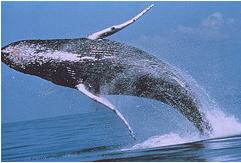
As you've probably heard, the rise of noise-pollution in the oceans has caused huge problems for marine life. Animals that echolocate -- like whales -- are increasingly deafened by the din of shipping vessels and military sonar. Indeed, it's apparently gotten so bad that we are now seeing a rise in collisions between whales and boats; it's bad for the whales, of course, but if if a small vessel hits a whale, even humans can die too.
This inspired Michel André, a marine biologist and biotechnology engineer, to develop a whale-avoidance system so that boats could detect nearby whales and steer away. The problem is that any "active" system -- something that sent our sonar probes -- would just add more noise to the oceans and further confuse the whales. He wanted to do it passively. So he started designing an array of listening devices that would listen for the clicks and whoops of whale-call, or even the sound of rain and waves splashing along silent whales.
But here's the really awesome part. As Gizmag reports:
A remarkable feature of his system is its ability to single out and track an individual whale among all its "family" members in the same area -- a breakthrough made with the help of a West African musician. After years of research, André's discovery that the sequence of acoustic signals transmitted by the sperm whales could be used to identify individual mammals -- a process called Rhythmic Identity Measurement (RIME) -- was almost by chance. In attempting to unravel the chaotic rhythms of the sperm whale clicks, he was struck by the similarity between his underwater recordings and African tribal music. A Senegalese griot (drummer) confirmed the likeness and -- amazingly -- was able to pick individual whales from André's recordings through their distinctive rhythmic structures.
A whale-detection system powered by algorithms derived from African drumming. Oh yes. I love the way that musicians always wind up being the ones who can understand whalespeak better than anyone else, like that guy who figured out that whales appear to have a particular affection for the clarinet note G.
Things you can do from here:
- Subscribe to collision detection using Google Reader
- Get started using Google Reader to easily keep up with all your favorite sites
Climate change policy and the Conservative-NDP Axis of Dimwits
Sent to you by nigel via Google Reader:
For reasons I'm going to explain shortly, the Conservatives and the NDP are unlikely allies in the debate on climate change policy. I'll be ripping into the idiocy of their positions pretty hard, so in order to balance what follows, I'm going to make a separate point as a sort of disclaimer. For more than a decade, the Liberal position was one of rank hypocrisy: sign the Kyoto Accord, scold people who questioned the wisdom of signing the Kyoto Accord, do absolutely nothing the meet the terms of the Kyoto Accord, and - after the 2006 election - harshly criticise the Conservative government for not being able to defuse the noxious stink-bomb that the Kyoto Accord had become. Right now, the Liberals have the most sensible climate change policy of the three major parties, but their record on this file up until the past few months is nothing at all to be proud of.
There are several levels at which this debate plays out:
- The first-order question about the relative merits of a carbon tax and a cap-and-trade model isn't really much of a debate at all: as I've explained in the Econ 101 version of the problem, the two approaches are basically equivalent. In both systems, there will be higher prices for activities that generate greenhouse gases, and in both systems, quantities will be reduced.
- The next issue is how to handle the redistributive effects of these higher prices. It's pretty clear that low-income households will be hit (relatively) harder by the increase in the prices of such basic goods as gasoline, natural gas, heating oil and electricity. The more concerned you are with income inequality, the harder you will argue the case for using the revenues generated - either from the carbon tax or the sale of emission permits - to offset the hardships that climate change policy will impose on low-income households.
- Adding uncertainty to the Econ 101 model provides another source of genuine debate. If we don't know for certain just how sensitive demand is to changes in prices, then a case can be made for preferring one policy over the other. If you're less concerned about the effects on prices, then a cap-and-trade system will provide an assurance that the target for quantities will be met. If you're more concerned about the economic disruption associated with uncertainties about prices, then a carbon tax would provide more certainty on that front.
If the debate on climate change policy revolved around those last two points - that is, around differences of opinion on the importance of inequality and on whether or not we wanted to live with uncertainty about prices or about levels of emissions - then I would be proud to be living in a country where grown-ups discussed important issues in a sensible manner.
But I don't. And the reason why I don't is that significant elements in the electoral bases of both the Conservatives and the NDP have certain knee-jerk reactions that make it almost impossible to conduct a sensible dialogue:
- Those who have a visceral hatred of taxes will reject the carbon tax model, simply because the word 'tax' appears in it.
- Those who have a visceral hatred of corporations will jump at the chance of imposing caps as a way of 'Sticking It to The Man'.
Now, everyone has their irrational biases and blind spots: Liberal supporters have a tendency to be unable to recognise hypocrisy. But the problem here is that the Conservatives and the NDP are not even able to get to the point where they understand point 1) above, let alone engage in a serious discussion of points 2) and 3).
It's important to understand just how goofy the Conservative and NDP positions are. Both of them seem to think that their preferred variation of the cap-and-trade model will not inconvenience consumers, for really no better reason than the fact that they cannot - or will not - understand the basic economics of climate change policy.
Things you can do from here:
- Subscribe to Worthwhile Canadian Initiative using Google Reader
- Get started using Google Reader to easily keep up with all your favorite sites
Cdn Election Seat Projections
Sent to you by nigel via Google Reader:
Since 538 rocks my world, I figured it might be fun to try something similar for the federal campaign, so I've developed a seat projection system that uses a probabalistic approach. Here's the explanation, in as plain English as I could put it. Feel free to e-mail me or ask for clarification in the comments section - I'm open to suggestions for improvements:
1. I've collected all the publicly available polling data released since September 1st (Nanos, Leger, Segma, Environics, Ipsos, Angus, Decima, SC, and CROP). I've only included data where regional splits are available.
2. A weighted average of the data is calculated for each region, assuming a 3 day half life for polling data. What that means is that a 3 day old sample of 500 from Quebec is weighted equally to a 6 day old sample of 1000 from Quebec - both would be counted as 250 completes. The "days old" number is based on the middle night of polling.
3. At this point, each seat is projected based on the change in the region. So if the Liberals are up 10% in Alberta (ha ha ha), they get 10% added to each seat. Sort of. In order to make the model more realistic, I've weighted the "base" for each seat 3/4 from 2006 and 1/4 from 2004, to reflect any "bizarre" fluctuations that may have happened last election due to local candidates, etc. I've also made a correction for incumbents retiring (between 2004 and 2006, the "incumbency factor" was worth 4.1% once regional changes were controlled for). And, in ridings where a by election has been held, I've given the by election and last election equal weighting. The important thing to remember is that, even after all this, everything gets projected to the regional numbers. So regardless of the tweakings, the numbers projected in Atlantic Canada will match the polling data.
4. And I could quit at this point and just list the projected wins and loses. But the problem with that is that a projected 2% Liberal win counts as 1 Liberal seat, as does a 30% projected Liberal win. And when you consider all the error associated with these projections, the two are definitely not even. So I decided to go the simulation route.
So I ran 1000 simulated elections. In each one, the regional numbers were simulated based on the sample size for the region (using the half-life discussed above). And then each riding was given a "random shift" based on the "regional to riding variance" observed when I ran this same model on the 2006 election using 2004 data (standard error of about 4% for each riding).
So in each of these 1000 elections I've got a winner in every riding. That means I can project a "probability of victory" for each seat, and get an average number of seats won per party.
It should be noted that this is all assuming the election is held today...I'm not predicting future shifts in popular support. It's also assuming the polling numbers are accurate. And it's not going to take into account a lot of the "unique" riding dynamics (Bill Casey, Lizzie May, etc) or different shifts that might be occuring between, say, Vancouver and rural BC.
So, based on the simulations, here are the results and graphs:
National
Conservatives: 137.9 (95% CI from 132 to 144)
Liberals: 98.5 (95% CI from 93 to 104)
NDP: 28.8 (95% CI from 25 to 32)
Bloc: 42.0 (95% CI from 39 to 45)
Indepent: 0.8 (Andre Arthur is the only independent who's going to show up on this model and, regardless of whatever the projections say, he's pretty much a lock since the Tories aren't challenging him)
It should be noted that, up until a few days ago when the Decima and Nanos polls rolled in, this model was projecting a high probability of a Tory majority.
Here are the regional breaks:
Atlantic Canada
Liberal: 22.2
Conservative: 6.5
NDP: 3.3
Quebec
Bloc: 42.0
Liberal: 16.0
Conservative: 15.4
NDP: 0.8
Ind: 0.8
Ontario
Conservative: 51.4
Liberal: 44.3
NDP: 10.2
Prairies
Conservative: 19.4
Liberal: 4.7
NDP: 3.9
Alberta
Conservative: 27.7
Liberal: 0.3
BC + Territories
Conservative: 17.4
Liberal: 11.0
NDP: 10.6




See Also: Barry Kay Projections, Hill and Knowlton Projector, UBC Election Stock Market
Things you can do from here:
- Subscribe to CalgaryGrit using Google Reader
- Get started using Google Reader to easily keep up with all your favorite sites
The Palin interview
The truly toxic combination of traits GW Bush brought to decision making was:
1) Ignorance
2) Lack of curiosity
3) "Decisiveness"
That is, he was not broadly informed to begin with (point 1). He did not seek out new information (#2); but he nonetheless prided himself on making broad, bold decisions quickly, and then sticking to them to show resoluteness.
We don't know about #2 for Palin yet -- she could be a sponge-like absorber of information. But we know about #1 and we can guess, from her demeanor about #3. Most of all we know something about the person who put her in this untenable role.
Sent to you by nigel via Google Reader:
It is embarrassing to have to spell this out, but for the record let me explain why Gov. Palin's answer to the "Bush Doctrine" question -- the only part of the recent interview I have yet seen over here in China -- implies a disqualifying lack of preparation for the job.
Not the mundane job of vice president, of course, which many people could handle. Rather the job of potential Commander in Chief and most powerful individual on earth.
The spelling-out is lengthy, but I've hidden most of it below the jump.
Each of us has areas we care about, and areas we don't. If we are interested in a topic, we follow its development over the years. And because we have followed its development, we're able to talk and think about it in a "rounded" way. We can say: Most people think X, but I really think Y. Or: most people used to think P, but now they think Q. Or: the point most people miss is Z. Or: the question I'd really like to hear answered is A.
Here's the most obvious example in daily life: Sports Talk radio.
Mention a name or theme -- Brett Favre, the Patriots under Belichick, Lance Armstrong's comeback, Venus and Serena -- and anyone who cares about sports can have a very sophisticated discussion about the ins and outs and myth and realities and arguments and rebuttals.
People who don't like sports can't do that. It's not so much that they can't identify the names -- they've heard of Armstrong -- but they've never bothered to follow the flow of debate. I like sports -- and politics and tech and other topics -- so I like joining these debates. On a wide range of other topics -- fashion, antique furniture, (gasp) the world of restaurants and fine dining, or (gasp^2) opera -- I have not been interested enough to learn anything I can add to the discussion. So I embarrass myself if I have to express a view.
What Sarah Palin revealed is that she has not been interested enough in world affairs to become minimally conversant with the issues. Many people in our great land might have difficulty defining the "Bush Doctrine" exactly. But not to recognize the name, as obviously was the case for Palin, indicates not a failure of last-minute cramming but a lack of attention to any foreign-policy discussion whatsoever in the last seven years.
Two details in Charles Gibson's posing of the question were particularly telling. One was the potentially confusing way in which he first asked it. On the page, "the Bush Doctrine" looks different from "the Bush doctrine." But when hearing the question Palin might not have known whether Gibson was referring to the general sweep of Administration policy -- doctrine with small d -- or the rationale that connected 9/11 with the need to invade Iraq, the capital-D Doctrine. So initial confusion would be understandable -- as if a sports host asked about Favre's chances and you weren't sure if he meant previously with the Packers or with the Jets. Once Gibson clarified the question, a person familiar with the issue would have said, "Oh, if we're talking about the strategy that the President and Condoleezza Rice began laying out in 2002...." There was no such flash of recognition.
The other was Gibson's own minor mis-statement. American foreign policy has long recognized the concept of preemptive action: if you know somebody is just about to attack you, there's no debate about the legitimacy of acting first. (This is like "shooting in self-defense.") The more controversial part of The Bush Doctrine was the idea of preventive war: acting before a threat had fully emerged, on the theory that waiting until it was fully evident would mean acting too late.
Gibson used the word "preemptively" -- but if a knowledgeable person had pushed back on that point ("Well, preemption has was what John F. Kennedy had in mind in acting against the imminent threat of Soviet missiles in Cuba"), Gibson would certainly have come back to explain the novelty of the "preventive war" point. Because he knows the issue, a minor mis-choice of words wouldn't get in the way of his real intent.
Sarah Palin did not know this issue, or any part of it. The view she actually expressed -- an endorsement of "preemptive" action -- was fine on its own merits. But it is not the stated doctrine of the Bush Administration, it is not the policy her running mate has endorsed, and it is not the concept under which her own son is going off to Iraq.
How could she not know this? For the same reason I don't know anything about European football/soccer standings, trades, or intrigue. I am not interested enough. And she evidently has not been interested enough even to follow the news of foreign affairs during the Bush era.
A further point. The truly toxic combination of traits GW Bush brought to decision making was:
1) Ignorance
2) Lack of curiosity
3) "Decisiveness"
That is, he was not broadly informed to begin with (point 1). He did not seek out new information (#2); but he nonetheless prided himself on making broad, bold decisions quickly, and then sticking to them to show resoluteness.
We don't know about #2 for Palin yet -- she could be a sponge-like absorber of information. But we know about #1 and we can guess, from her demeanor about #3. Most of all we know something about the person who put her in this untenable role.
Things you can do from here:
- Subscribe to James Fallows using Google Reader
- Get started using Google Reader to easily keep up with all your favorite sites
Thursday, September 11, 2008
9/11 Anniversary in Photos
Sent to you by nigel via Google Reader:
9/11 in photos, then and now, via the Boston Globe. My own unplanned remembrance this morning just stretched out much longer courtesy of these alternately inspiring and heartbreaking pictures.

Things you can do from here:
- Subscribe to Paul Kedrosky's Infectious Greed using Google Reader
- Get started using Google Reader to easily keep up with all your favorite sites
Cows align themselves with magnetic north
Sent to you by nigel via Google Reader:
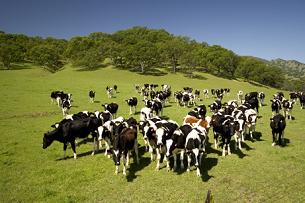
I'm coming a bit late to this one, but apparently a new study has unveiled a curious new fact about cows: They align themselves with Earth's magnetic field.
In a the paper "Magnetic alignment in grazing and resting cattle and deer" -- published in an August issue of the Proceedings of the National Academy of Sciences -- a team of German zoologists used Google Earth to examine images of 8,510 cattle and 2,974 deer in hundreds of locations across the Czech Republic. The result? Whether standing and grazing or resting, the cows and deer tended to align themselves with magnetic north or south. We've known for years than smaller mammals like birds, turtles and fish can sense the Earth's magnetic fields, but nobody thought really big mammals could do so.
The funny part is that the scientists now wonder whether this ought to be taken into considering in the architecture of barns. As Sabine Bengall, one of the zoologists, told National Geographic News:
Begall and her co-authors also note it's unclear why cows and deer would align themselves with Earth's magnetism. But it could have management implications, she suggests.
"If we assume that our findings are real, we could ask what consequences does [barn] housing in east-west orientation have," she said.
"Does it influence the animals' physiology, as in milk production?"
Feng Shui for cows. Beyond awesome.
The other delightful part of this story is how the scientists conducted their research: Via Google Earth. They realized that it would be "difficult, or maybe impossible, to do these studies in the lab". But Google Earth allowed them to quickly collect massive amounts of data. Indeed, that's the remarkable thing here. Anyone -- you or I -- could have done this study, using data that Google has already collected.
UPDATE: Thanks to Ian York and Lisa Mandle for sending me a copy of the paper! I'd wanted to see if it included any of the Google Earth images so I could excerpt them, but sadly it didn't. That current picture I'm running above is the cow-herd shot that accompanies the story in National Geographic.
Things you can do from here:
- Subscribe to collision detection using Google Reader
- Get started using Google Reader to easily keep up with all your favorite sites



